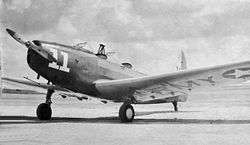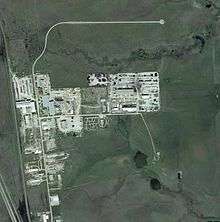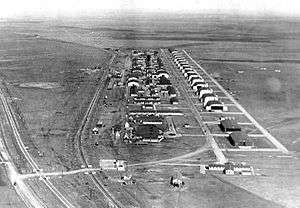Hicks Field
| Hicks Field Camp Taliaferro Field #1 | |
|---|---|
| Located near Saginaw, Texas | |
|
Hicks Field, Texas, 1918 | |
 Hicks Field | |
| Coordinates |
32°54′44″N 97°24′05″W / 32.91222°N 97.40139°W Hicks Field 32°54′57″N 97°25′21″W / 32.91583°N 97.42250°W Bombing Target |
| Type | Pilot training airfield |
| Site information | |
| Controlled by |
|
| Condition | Redeveloped as industrial park |
| Site history | |
| Built | 1916 |
| In use | 1916–1945 (military), 1945–ca.1976 (civil airfield) |
| Battles/wars |
World War I World War II |
| Garrison information | |
| Garrison |
Training Section, Air Service (World War I) Army Air Force Training Command (World War I) |

Hicks Field (Camp Taliaferro Field #1) is a former World War I military airfield, located 5.6 miles (9.0 km) North-northwest of Saginaw, Texas. It operated as a training field for the Air Service, United States Army between 1917 until 1920. It was one of thirty-two Air Service training camps established after the United States entry into World War I in April 1917.[1]
After the United States' entry into World War I in April 1917, General John J. "Blackjack" Pershing invited the British Royal Flying Corps to establish training fields in Texas for the training of American and Canadians volunteers because of its mild weather. After looking at sites in Dallas, Fort Worth, Waco, Austin, Wichita Falls and Midland, three sites were established in 1917 in the Fort Worth vicinity (known as the "Flying Triangle."), those being Hicks Field (#1), Barron Field (#2), and Benbrook Field (#3).
Canadians named the training complex Camp Taliaferro after Walter Taliaferro, a US aviator who had been killed in an accident. Camp Taliaferro was headquartered under the direction of the Air Service, United States Army, which had an administration center near what is now the Will Rodgers Memorial Center in Fort Worth, Texas.
History
Taliafero Field No. 1 was used by the Royal Flying Corps from October 1917 to April 1918 as a training field for American and Canadian pilots. It was then turned over to the Air Service, United States Army. The Americans renamed the field Hicks Field, after Charles Hicks, who owned the Hicks Ranch on which the airfield was built.
World War I
The first trainees arrived in November 1917 to a very crude facility. Most structures were unfinished and personnel lived and worked in canvas tents. The Flu Epidemic killed many assigned personnel. The airfield was taken over by United States Army in April 1918. The Curtiss JN-4 "Jenny" became the primary aircraft used for flight training after the Army takeover.
Training units assigned to Hicks Field were:[2]
- Post Headquarters, Hicks Field - October 1919
- 78th Aero Squadron, February 1918
- Re-designated as Squadron "A", July–November 1918
- 79th Aero Squadron, February 1918
- Re-designated as Squadron "B", July–November 1918
- 82d Aero Squadron, March 1918
- Re-designated as Squadron "C", July–November 1918
- 206th Aero Squadron, April 1918
- Re-designated as Squadron "D", July–November 1918
- 275th Aero Squadron, February 1918
- Re-designated as Squadron "E", July–November 1918
- Flying School Detachment (Consolidation of Squadrons A-E), November 1918-November 1919
The 22d, 27th, 28th, 139th, 147th, and 148th US Aero Squadrons trained at the facility. Military use ended in early 1919 after the end of World War I.
In 1923, the field became the location of the world's first helium plant, operated by United States Navy. It became a Navy blimp facility until 1929 when shortages closed facility.
World War II


In preparation for the eventual U.S. entry into World War II, the United States Army Air Corps sought to expand the nation's combat air forces by asking civilian flight schools to provide the primary phase of training for air cadets. Consequently, it contracted with civilian flying schools to provide primary flying training, with the graduates being moved on to basic and advanced training at regular military training airfields.[3]
Taken over by United States Army Air Corps in 1940, Hicks Field was reopened and its facilities improved. It was used as a contract primary flight training facility by the USAAF Gulf Coast Training Center (later Central Flying Command). The Texas Aviation School and the W. F. Long Flying School provided flying training to aviation cadets. Initially under supervision of 307th Army Air Forces Flying Training Detachment, later re-designated as 2555th Army Air Forces Base Unit (Contract Pilot School, Primary) on 1 May 1944. A ten-week course of primary training continued at Hicks, and a total of 2,403 cadets were processed, and about 70% made it to the next level of training at Randolph Field.
Flying training was performed with Fairchild PT-19s as the primary trainer. Also had several PT-17 Stearmans and a few P-40 Warhawks were assigned. The field was inactivated 20 July 1944 with the drawdown of AAFTC's pilot training program, declared surplus, and turned over to the Army Corps of Engineers. It was eventually discharged to the War Assets Administration (WAA) and returned to civil control.
Civil use
Hicks Field was converted to a civil airport by April 1945.[4] Postwar use included storage and sale of surplus military aircraft. In 1954, Hicks was used by Bell Helicopter for flight testing of the HSL anti-submarine warfare helicopter.[5]

During the 1950s, two Bell Helicopter pilots found a recessed actual-sized World War I biplane silhouette west of the old Hicks Field location. Locals say it was used for practice bombing (using bags of flour) & for some strafing practice. Over the years the local farmers fenced in the site, hoping to protect it in some way. The site is on the West side of the creek and just on the opposite side from a new gas-well-head site on the creek.
Hicks fell into disuse by 1976, having been removed from maps, and with only a few businesses remaining. In 1985, the similarly named but unrelated Hicks Airfield opened a short distance away. The original airfield was redeveloped into an industrial park by the early 1990s, although a few World War II-era hangars still stood.[4]
Today, the site of Hicks Field is an industrial complex, and very little remains of its aviation past. Hicks Field Road crosses the property, its name reflecting the former airfield. The northern part of the airfield is dotted with natural gas wells, the southern part being a steel recycling yard. The station area part of Hicks Field is totally obliterated with open storage yards, new buildings and other structures; the railroad spur running through the airfield remaining and is still in use for freight traffic through the industrial area. Some World War II aircraft hangars remain, apparently in use as warehouses, all of which are in a deteriorated state. None of the World War I nor World War II buildings remain, although some concrete pads in the area may be some foundations of them.
There is a new housing addition a half mile northwest from the site and the entrance to the housing is from Bonds Ranch Road. The road to the location is not for public access.
See also
- List of Training Section Air Service airfields
- Texas World War II Army Airfields
- 31st Flying Training Wing (World War II)
References
![]() This article incorporates public domain material from the Air Force Historical Research Agency website http://www.afhra.af.mil/.
This article incorporates public domain material from the Air Force Historical Research Agency website http://www.afhra.af.mil/.
- ↑ William R. Evinger: Directory of Military Bases in the U.S., Oryx Press, Phoenix, Ariz., 1991, p. 147.
- ↑ Order of Battle of the United States Land Forces in the First World War, Volume 3, Part 3, Center of Military History, United States Army, 1949 (1988 Reprint)
- ↑ Cameron, Rebecca Hancock, 1999, Training to Fly. Military Flight Training 1907-1945, Air Force Historical Research Agency, Maxwell AFB, Alabama
- 1 2 Cravens, Chris; Leatherwood, Art. "Hicks Field". Handbook of Texas Online. Texas State Historical Association. Retrieved 3 October 2014.
- ↑ Pate, J'Nell L. Arsenal of Defense: Fort Worth's Military Legacy. College Station, Texas, United States: Texas A&M University Press, 2011, ISBN 9780876112588, page 143.
External links
| Wikimedia Commons has media related to Hicks Field (Airfield). |
- Shaw, Frederick J. (2004), Locating Air Force Base Sites History’s Legacy, Air Force History and Museums Program, United States Air Force, Washington DC, 2004.
- Manning, Thomas A. (2005), History of Air Education and Training Command, 1942–2002. Office of History and Research, Headquarters, AETC, Randolph AFB, Texas ASIN: B000NYX3PC
- Taliaferro Field / Hicks Field at Abandoned & Little-Known Airfields

